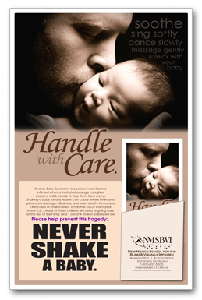|
Home | Programs | Contact | News & Events | For Parents | For Students | VI Resources | Photos |
||
|
|
||
|
Many of the children who survive the abuse of Shaken Baby Syndrome are faced with long term visual impairments, quite often the result of the brain injury (cortical visual impairments or CVI) and or optic nerve damage they incurred. This may well be in addition to numerous other potential difficulties and impairments such as learning disabilities, cognitive delays, physical impairments, and seizures disorders. Presently at the New Mexico School for the Blind and Visually Impairedís Early Childhood Program, 12.9% of our students are visually impaired as a result of Shaken Baby Syndrome. Moreover, the Early Intervention (birth to 3 years) component of our program reports that approximately 4.2% of their current caseload is the result of this non-accidental trauma. Enrollment projections for our preschoolís 2010-2011 school year already indicate more incoming children with similar etiologies.
A number of these children have received services from
our program for children with visual impairments within a month or two
of their release from the hospital following their injury. At ages 3 to
6 years now these children show a variety of abilities and challenges.
For some, visual processing skills have improved; for others, they
continue to demonstrate minimal visual responsiveness and thus must
learn to use their other senses as efficiently as possible to help them
make the most sense of their world.
∑ If
you would like to join the effort by displaying the bumper sticker or
hanging up a poster, To download a printable PDF version of our information card (with tips courtesy of the National Center on Shaken Baby Syndrome), please click here:
Downloadable Information
Page: "20 Tips to Soothe Your Crying
Infant"
20 Tips
to Soothe Your Crying Infant The list above is not an all inclusive list, as there are many other things you can try to calm your babyís crying. Remember... while many of these techniques will work most of the time, nothing works all the time and thatís okay; this does NOT mean thereís anything wrong with you or your baby! If you start to become frustrated, itís time to put your baby down in a safe place, walk away for a few minutes, and calm yourself down a bit.
For more information please contact:
|
||
|
|
||
| Serving the Youth of New Mexico and Their Families since 1903 | ||
| Please read the
Terms
And Conditions Of Use
carefully before using this site. If you do not agree to these terms and conditions of use, please do not use this site. Comments to: webmaster@nmsbvi.k12.nm.us Last Updated: 4/26/2010 |


